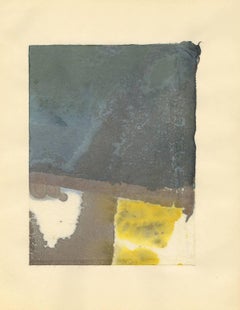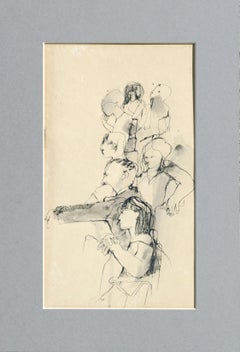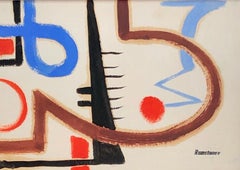Lee Hall Art
to
1
1
1
Overall Height
to
Overall Width
to
1
1
1
1
6,827
3,114
2,517
1,217
1
1
Artist: Lee Hall
Connecticut Summer Fragments
By Lee Hall
Located in New York, NY
Lee Hall (1934-), Connecticut Summer Fragments, a portfolio of watercolor, 29 in all, each about 5 ¼ x 7 ¼ inches, on hand made paper attached to a backing, i...
Category
1970s American Modern Lee Hall Art
Materials
Watercolor
Related Items
The Sketch Class, Figurative Study Line Drawing
By David Rosen (b.1912)
Located in Soquel, CA
Expressive line drawing figure study featuring a group of figures in a classroom by David Rosen (Canadian, 1912-2004). Unsigned, but was acquire...
Category
Late 20th Century American Modern Lee Hall Art
Materials
Paper, Pen, Watercolor
H 12 in W 8 in D 0.25 in
MODERNIST DRAWING New Hope Mid-Century WPA Abstract Non-Objective Jazz Modern
By Ramstonev (Ramsey/Stone/Evans co-operative)
Located in New York, NY
MODERNIST DRAWING New Hope Mid-Century WPA Abstract Non-Objective Jazz Modern. Signed with a "Ramstonev" stamp lower right.
RAMSTONEV Cooperative Art Project (1937-1939). In the late 1930s, Charles Ramsey became close friends with Charles Evans and Louis Stone. He persuaded them to join him teaching his New Hope summer classes in non-objective painting. Soon, a history-making collaboration began. In 1937, meeting in Evans' studio at the rear of Cryer's Hardware store on Main Street in New Hope, a decision was made to establish the Co-Operative Painting Project. They were intrigued by the cooperative ad-lib process by which jazz musicians created their music. Believing this to be the quintessential American contribution to music, they theorized that a similar result might be obtainable with art, a "visual jam session." This particlarly fascinated Ramsey, who was a jazz buff and had a large collection of jazz records.
The objective was to jointly collaborate in the creation of a painting as well as applying collective criticism during its creation. By creating forward movement by general consent, they believed they could produce a higher level of beauty. By consensus it was decided that subject matter would be non-objective. Up to eight people would participate and stop when the painting "felt" finished by common agreement.
These co-operative works were done in several different mediums- the majority in pastel, but some in watercolor, gouache, graphite or cut paper collage. On occasion, the group would create a series, as opposed to a single work, created in steps by three or four artists. One of the occasional participants was famed New Hope poet, Stanley Kunitz. These series could range in number from four to sixteen paintings in each. The first of a series would be very basic and the last a fully finished work.
In the scope of importance among the New Hope Modernist...
Category
1930s American Modern Lee Hall Art
Materials
Gouache, Paper, Watercolor
Large Modernist Abstract Expressionist Gouache Painting Bauhaus Weimar Artist
By Pawel Kontny
Located in Surfside, FL
Abstract watercolor or gouache composition bearing the influence of the earlier color-block compositions of Paul Klee.
Pawel August Kontny, (Polish-German-American artist) He was born in Laurahuette, Poland, in 1923, the son of a wealthy pastry shop owner. In 1939 he began studying architecture in Breslau where he was introduced to the European masters and to the work of some of the German Expressionists, soon afterward banned as "degenerate artists" and removed from museums throughout Germany by the Nazi regime. His studies were interrupted by World War II. Drafted into the German army, traveling in many countries as a soldier, he sketched various landscapes but in 1945, he was captured and held as a prisoner of war in Italy. After the war, he studied at the Union of Nuremberg Architects to help design buildings to replace ones destroyed in the war. He recorded his impressions of the local population and the landscapes through his watercolors and drawings. Pawel Kontny thereafter moved to Nuremberg, Germany, becoming a member of the Union of Nuremberg Architects and helping to rebuild the city's historic center. He soon decided to concentrate on his professional art career. He married Irmgard Laurer, a dancer with the Nuremberg Opera. Pavel Kontny 's career as an artist was launched with his participation in an all German exhibition, held at the Dusseldorf Museum in 1952. He held one-man shows in Germany, Switzerland and the United States. During his trip to the United States in 1960, Kontny became instantly enamored with Colorado, and decided to relocate to Cherry Hills with his wife and two children. He quickly established himself in the local art community, being affiliated for a time with Denver Art Galleries and Saks Galleries. His subject matter became the Southwest. During this time he received the Prestigious Gold Medal of the Art Academy of Rome. His extensive travel provided material for the paintings he did using his hallmark marble dust technique. he also worked equally in pastel, watercolor, charcoal and pencil-and-ink. in a style which merged abstraction and realist styles, influenced by Abstract Expressionist painting and South Western American landscapes. In the early 1960s he was one of only a few European-born professional artists in the state, a select group that included Herbert Bayer (1900-1985), a member of the prewar Bauhaus in Weimar and Dessau, Germany, and Roland Detre (1903-2001), a Hungarian modernist painter. As a Denver, Colorado resident, Pavel Kontny exhibited at galleries and museums throughout the United States, Germany and Japan. There, he was inspired by frequent trips to Native American pueblos in the Southwest, as well as by the study of the Plains Indians of Montana and Wyoming. Over the years Kontny had a number of students and generously helped young artist by hosting exhibitions at his Cherry Hills home. For many years he generously donated his paintings to support charitable causes in Denver. Influences during his European years included German pastelist C.O. Muller, German Informel painter Karl Dahmen and Swiss artist, Hans Erni. In the early 1950s his painting style showed the influence of the Die Brücke (The Bridge), a group of German expressionist artists formed in Dresden in 1905 who had a major impact on the evolution of modern art in the twentieth century in Germany. By the middle of the decade his style incorporated more referential abstraction and total abstraction, resulting in part from his study of Hans Hartung, a German artist based in Paris who exhibited his gestural abstract work in Germany. The American moon landing in 1969 inspired Paul Kontny...
Category
20th Century American Modern Lee Hall Art
Materials
Watercolor, Archival Paper
1930s American Farm Scene, Landscape Watercolor Painting Farm Buildings Windmill
By Samuel Bolton Colburn
Located in Denver, CO
Original watercolor on paper painting by Samuel Bolton Colburn (1909-1993) of a small farm situated in a valley near the mountains. Presented in a custom frame, outer dimensions meas...
Category
1930s American Modern Lee Hall Art
Materials
Paper, Watercolor
"Country Haircut"
By Milton Avery
Located in Lambertville, NJ
Jim’s of Lambertville Fine Art Gallery is proud to offer this piece by Milton Avery (1885 – 1965).
Milton Avery was a prominent Modernist painter whose work combined abstraction and...
Category
1940s American Modern Lee Hall Art
Materials
Paper, Watercolor, Gouache
Modern Tropical Abstract -- "Spires II"
Located in Soquel, CA
Colorful abstract watercolor of imaginative shapes in a tropical setting with botanical landscape elements by Claire Wolf Krantz (American, b. 1938). Signed "Claire Wolf Krantz" lower right. Titled "Spires" lower center. Dated "11/18/77" and numbered "II" in a series lower left. Peach colored mat and bronze tone metal frame. Image, 14"H x 14"L.
Kranz is an artist and art critic living in Chicago, she uses fictional and real elements in her works. She is known for mixed media works layering photograph...
Category
1970s American Modern Lee Hall Art
Materials
Paper, Watercolor
Textile Design
By Andre Delfau
Located in Chicago, IL
A bright, geometric textile design (In red, white & blue) by stage and costume designer Andre Delfau.
Category
1950s American Modern Lee Hall Art
Materials
Ink, Gouache, Graphite
Study for Sculpture #2
By David Hayes
Located in Lawrence, NY
Gouache on paper
signed en verso
Throughout his sixty-year artistic career, David Hayes created sculptural forms abstracted from organic forms encountered in daily life. He first st...
Category
1980s American Modern Lee Hall Art
Materials
Gouache
Modern Abstract Watercolor Blue Cross Landscape
Located in Houston, TX
Modern abstract watercolor painting with blue and grey tones. The artist sketched out crosses within the blue abstract landscape. The piece is signed by the artist. It is framed in a silver metal frame with a white matte.
Dimensions without Frame: H 25 in x W 33 in.
Artist Biography: Peter Keefer...
Category
1980s American Modern Lee Hall Art
Materials
Watercolor, Pencil
'Rockport Harbor' — Mid-Century Modernism
By Louis Wolchonok
Located in Myrtle Beach, SC
Louis Wolchonok, 'Rockport Harbor', gouache, c. 1950. Signed in ink, lower right. A fine, modernist work, with fresh colors, on cream wove drawing pape...
Category
1950s American Modern Lee Hall Art
Materials
Gouache
Modernist Abstract Expressionist Watercolor Painting Bauhaus Weimar Pawel Kontny
By Pawel Kontny
Located in Surfside, FL
Abstract watercolor composition bearing the influence of the earlier color-block compositions of Paul Klee.
Pawel August Kontny, (Polish-German-American artist) He was born in Laurahuette, Poland, in 1923, the son of a wealthy pastry shop owner. In 1939 he began studying architecture in Breslau where he was introduced to the European masters and to the work of some of the German Expressionists, soon afterward banned as "degenerate artists" and removed from museums throughout Germany by the Nazi regime. His studies were interrupted by World War II. Drafted into the German army, traveling in many countries as a soldier, he sketched various landscapes but in 1945, he was captured and held as a prisoner of war in Italy. After the war, he studied at the Union of Nuremberg Architects to help design buildings to replace ones destroyed in the war. He recorded his impressions of the local population and the landscapes through his watercolors and drawings. Pawel Kontny thereafter moved to Nuremberg, Germany, becoming a member of the Union of Nuremberg Architects and helping to rebuild the city's historic center. He soon decided to concentrate on his professional art career. He married Irmgard Laurer, a dancer with the Nuremberg Opera. Pavel Kontny 's career as an artist was launched with his participation in an all German exhibition, held at the Dusseldorf Museum in 1952. He held one-man shows in Germany, Switzerland and the United States. During his trip to the United States in 1960, Kontny became instantly enamored with Colorado, and decided to relocate to Cherry Hills with his wife and two children. He quickly established himself in the local art community, being affiliated for a time with Denver Art Galleries and Saks Galleries. His subject matter became the Southwest. During this time he received the Prestigious Gold Medal of the Art Academy of Rome. His extensive travel provided material for the paintings he did using his hallmark marble dust technique. he also worked equally in pastel, watercolor, charcoal and pencil-and-ink. in a style which merged abstraction and realist styles, influenced by Abstract Expressionist painting and South Western American landscapes. This one bears the influence of Sam Francis. In the early 1960s he was one of only a few European-born professional artists in the state, a select group that included Herbert Bayer (1900-1985), a member of the prewar Bauhaus in Weimar and Dessau, Germany, and Roland Detre (1903-2001), a Hungarian modernist painter. As a Denver, Colorado resident, Pavel Kontny exhibited at galleries and museums throughout the United States, Germany and Japan. There, he was inspired by frequent trips to Native American pueblos in the Southwest, as well as by the study of the Plains Indians of Montana and Wyoming. Over the years Kontny had a number of students and generously helped young artist by hosting exhibitions at his Cherry Hills home. For many years he generously donated his paintings to support charitable causes in Denver. Influences during his European years included German pastelist C.O. Muller, German Informel painter Karl Dahmen and Swiss artist, Hans Erni. In the early 1950s his painting style showed the influence of the Die Brücke (The Bridge), a group of German expressionist artists formed in Dresden in 1905 who had a major impact on the evolution of modern art in the twentieth century in Germany. By the middle of the decade his style incorporated more referential abstraction and total abstraction, resulting in part from his study of Hans Hartung, a German artist based in Paris who exhibited his gestural abstract work in Germany. The American moon landing in 1969 inspired Paul Kontny...
Category
20th Century American Modern Lee Hall Art
Materials
Watercolor, Archival Paper
Untitled
By Louisa Chase
Located in New York, NY
Signed (at lower right): Louisa Chase
Category
Late 20th Century American Modern Lee Hall Art
Materials
Charcoal, Ink, Watercolor, Pencil
Lee Hall art for sale on 1stDibs.
Find a wide variety of authentic Lee Hall art available for sale on 1stDibs. You can also browse by medium to find art by Lee Hall in paint, watercolor and more. Much of the original work by this artist or collective was created during the 1970s and is mostly associated with the modern style. Not every interior allows for large Lee Hall art, so small editions measuring 8 inches across are available. Customers who are interested in this artist might also find the work of Winold Reiss, Abraham Walkowitz, and Leon Kelly. Lee Hall art prices can differ depending upon medium, time period and other attributes. On 1stDibs, the price for these items starts at $7,500 and tops out at $7,500, while the average work can sell for $7,500.


